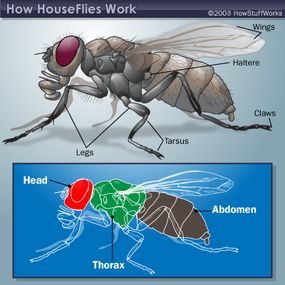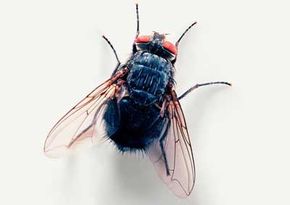Housefly Anatomy: Wings, Legs and Abdomen
The housefly's thorax features all of its limbs used for movement. Though flies appear to have only one pair of wings, closer inspection reveals the presence of tiny, secondary wings, called halters, located below the main pair.
While their ancient ancestors boasted two full sets of wings, houseflies have learned to do more with less. Over millions of years, the lower set evolved into the shrunken appendages you see today. They're far from useless, however. Houseflies flap their halters at high speeds during flight, using them to maintain balance in the air. If one halter is removed, the insect can only fly in circles. Without either halter, the fly can't take to the air at all.
Advertisement
The primary wings do the rest of the work, beating 200 to 300 times a second for an average speed of 4.5 miles (7.24 kilometers) per hour. The wings provide enough power and precision for instant liftoff and complicated flight movements, such as tight spirals, zigzags and even backward maneuvers.
And then there are the legs, which the fly uses to taste everything it lands on. Tiny hairs on the end leg segment, or tarsi, work like human taste buds. For this reason, you can often spot houseflies walking around in circles on potential meals.

If you happened to observe the same fly walking on the wall or ceiling, then you saw the other portions of the tarsi in action. The bottom of the housefly's feet boast tiny, gripping claws and moist suction pads called pulvilli, which allow the fly to land almost anywhere.
The abdomen contains other key organs, including an egg-laying ovipositor (in females) and a sperm-depositing aedeagus (in males). Both remain retracted when not in use.
So houseflies seem to have all the equipment to find a meal, but how do they go about eating it? Find out on the next page.
